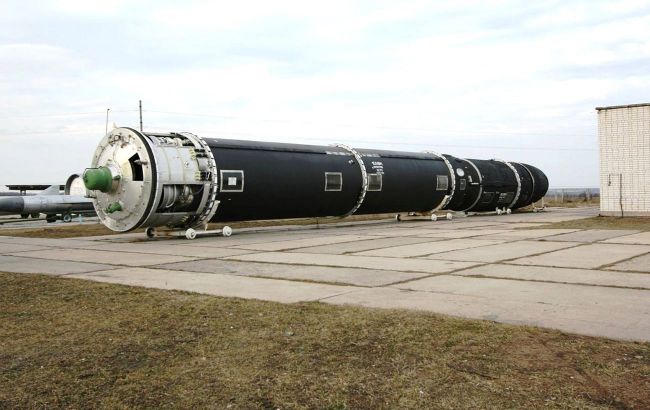Mysterious explosion at Russian cosmodrome: Nuclear Sarmat may have failed mid-flight
 Illustrative photo: Russian nuclear missile Satana — the direct predecessor of the Sarmat (Russian media)
Illustrative photo: Russian nuclear missile Satana — the direct predecessor of the Sarmat (Russian media)
A powerful explosion occurred at the Yasnoe cosmodrome in Russia’s Orenburg region on the afternoon of November 28. According to preliminary information, another test of the Sarmat nuclear missile may have been conducted there, which ended extremely unsuccessfully for Russia, according to Ukrainian monitoring channels and the Defense Express outlet.
The Yasnoe cosmodrome is located in Russia’s Orenburg region, near the city of the same name and not far from the border with Kazakhstan. On November 28, photos and videos of the explosion near the cosmodrome began appearing online, followed later by footage of an object resembling a missile falling.
After the explosion, a huge cloud of toxic orange-purple smoke rose into the air. The Russian authorities have not issued an official comment, while local outlets wrote that there would be no evacuation from Yasnoe — claiming that the smoke cloud poses no threat to people and that "everything is fine."




However, Defense Express notes that the color of the cloud after the explosion is characteristic of something highly poisonous — for example, rocket fuel, which is extremely toxic.
"Such a color is typical only for missiles that use highly toxic fuel — the nitrogen tetroxide and unsymmetrical dimethylhydrazine pair, better known as amyl and heptyl. It is precisely amyl and heptyl that are used in the fuel of a whole range of Soviet and now Russian missiles," the outlet writes.
The same type of fuel is used in Russia’s Proton rockets, which launch payloads into space. After unsuccessful Proton launches, when rockets exploded, clouds of the same color would appear. The fuel is extremely toxic and mutagenic: after each Proton launch, Kazakhstan would bill Russia 70–90 million dollars for cleanup.
At the same time, the Yasnoe cosmodrome is in fact not so much a cosmodrome as a missile launch base — one of 11 locations in Russia from which missiles with nuclear warheads can be launched. Moreover, there had been no information about Russia preparing space launches or conducting nuclear force exercises.
"But everything falls into place if we assume that these were yet another failed tests of the RS-28 Sarmat intercontinental ballistic missile," the outlet concludes.
The thing is that Sarmat tests at Plesetsk led to the missile exploding right in the launch silo on September 21, 2024. As a result, both the silo and the test facility were destroyed. Thus, the only more or less suitable location for Sarmat launches that remained was the Yasnoe cosmodrome, from which modernized R-36 Dnepr missiles were launched in 2015.
"Because the RS-28 Sarmat is a modernization of the R-36 and must be launched from existing silos for this missile. And it also flies on the amyl–heptyl fuel pair," the outlet summed up.
Missiles that don’t fly
Recently, the Russian President Vladimir Putin boasted about Russia’s new "wonder weapon." In particular, he spoke about the Burevestnik cruise missile, which allegedly "has no analogues in the world." The Russians claim they have already tested it, but there is no evidence beyond their statements.
He also mentioned the Sarmat missile, once again claiming that it has supposedly been "put into service." However, Putin has been making the same claims about this missile since 2021, so there is no reason to believe the Russian President.
The RS-28 Sarmat intercontinental ballistic missile is Russia’s fifth-generation silo-based strategic missile system. There are many rumors surrounding this missile — Russians claim it can carry a 7.5–8 megaton nuclear warhead across 18,000 kilometers and "break through any missile defense system." Yet since 2021, almost all Sarmat tests have failed: the missile that has supposedly been "put into service" at least three times still does not fly.

